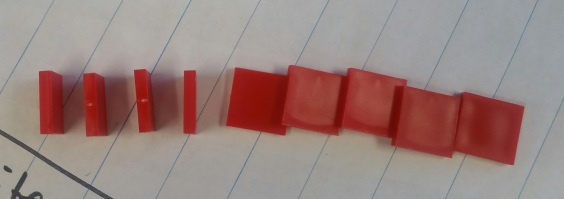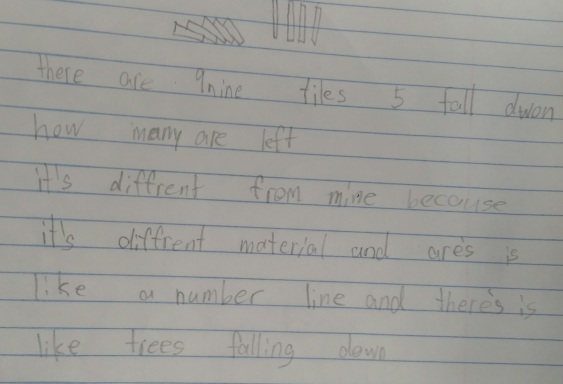Before
It’s the third year that I spend some intentional time in my classroom working on a “making friendly numbers” subtraction strategy: 234 – 19 = 235 – 20. I was not happy about my previous two attempts. Some kids I think just bought into it, some kept confusing it with addition (take from one number and add to another); in any case, I felt like students were not able to figure out why this works, and they either took my word for it or tossed it away. In year one, I gave it to them. In year two, I made a lesson with Cuisenaire rods. I offered my students a great model they didn’t really care for at that moment.
A few students brought this strategy up this year during our number talks. “Why does it work?” – “I don’t know, my teacher told me it always does.” It was time to try again for the third time.
Original plan was a bit blurry: get the number string on, get students to notice the rule. Then model it with the snap cubes in two towers; let students work with partners to change the number of cubes in each tower without changing the difference.
Intermission 1
The new idea came after Mike Flynn’s session about exploring multiple representations, a first session in Effective Practices for Advancing the Teaching and Learning of Mathematics course in Mount Holyoke College. I tossed my original plans and decided to try and follow the example that was shared in the session; let students notice the pattern, come up with the claim and then prove the claim using their own representations.
Lesson 1: Developing the Claim
First lesson was a brief number talk. 3-1, 4-2, 5-3. Students noticed that if they add “1” to both subtraction numbers, it seems like the difference stays always the same. I also started recording the steps of mathematical thinking that we will follow. My worries during the lesson were that a few students did not seem to notice a pattern. I hoped that the Testing lesson will help.
Lesson 2: Testing the Claim
The plan was to ask students to spend 15 minutes testing the claim with as many examples as possible. Then things went sideways. “Can I try negative numbers?” We don’t teach integers operations until grade seven. I teach grade three. I panicked then said, “Go for it.” Then there were groups of kids engaging in some interesting discussions.
- It doesn’t work! (-5) – 3 is not the same as (-4) – 2!
- You are not subtracting -3, you are subtracting positive 3.
- If (-5 )– 3 = (-8), then what is -5 – (-3)?
Not sure what I was thinking when I briefly introduced integers earlier this year. You can’t give eight year old kids a new math toy and expect that they won’t play with it. I’m bracing myself for multiplication and division of integers in the spring.
One student discovered that if you subtract a number from itself, you will always get zero. From that moment on, he forgot about original claim and was testing his new discovery. I think we will be proving it next. It was all fun if not quite what I anticipated. At the end of 15 minutes we all agreed that the rule seems to always work.
Intermission 2
The plan was to now ask kids to use any models to prove this claim. And that’s when I realized that I didn’t allow my students to play with different tools and to develop their own subtraction models. We built numbers, we did not build “subtraction.” I felt we are not ready. I decided to let kids to explore different representations for subtraction first.
Lesson 3
“Today we will be testing the tools that we will later use to prove our claim.” Students worked in 4 groups to build a model, draw a diagram and write a story for 9-5=4. I had a selection of different items ready for the students to pick; from ten frames and balances to dominoes and snap cubes. First ten minutes were terrifying. Students used manipulatives to build symbols 9,5 and 4. I told that with their manipulatives they are trying to explain it to someone who might not anything about subtraction or symbols for numbers, but can count.
After all groups seemed to have come up with some working representations, students interviewed each other to find a representation that was different from their own and reflected on it in their math journals.


Closing Thoughts and Plans
These few lessons made me realize that when I ask kids to explain their thinking, I often give them my tools and they end up modeling my thinking rather than developing and explaining their own. They need to find their own tools and develop their own reasoning and I need to give them more opportunities to do it. On Monday we will move on to our proving.
Here is the template I made to plan my future Mathematical Reasoning Lessons.
Questions:
How do you lead students from drawing the picture to drawing the diagram? From building numerical symbols to building a model?









Wow, I’m impressed with the variety of tools and ways your students represented their mathematical thinking. Do they always come up with this many ways to show their thinking?
LikeLiked by 1 person
I wish I always gave them the chance. This whole experience taught me that I should trust my students more with finding their own ways.
I started a year with representing number 12 and kids were very creative. I still remember a hexagon made out of toothpicks with 6 more toothpicks connecting the vertices to the middle.
LikeLike